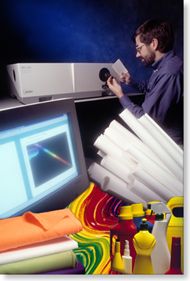|








|
| |

|
- Measure
in less than 10 minutes
- Measure
fluorescence and reflectance
- Supports
both UV and VIS activated fluorescence
- Measures
in 10 nm intervals
- Light excitation 300 - 780nm
- Light emission 380 - 780nm
- Excellent
Inter-instrument agreement
- Analyze
color under any illuminant
|
The
Labsphere BFC-450 Bispectral Fluorescence Colorimeter is a high
precision spectrophotometer designed for absolute measurement
and quantification of the color appearance of fluorescent materials.
The instrument provides accurate, repeatable and reproducible
colorimetric data of materials such as traffic control materials,
high visibility clothing, printing ink, plastics and paper.
The
BFC-450 conveniently connects to your computer via an IEEE-488
GPIB connector.
Windows™-based
software is easy to install and simple to use. Data obtained from
the BFC-450 provides valuable information for tighter color tolerancing
and consistency in manufacturing. The instrument offers researchers
and quality control professionals measurement versatility and
performance historically unavailable in fluorescent color measurements.
The BFC-450
uses the same operating principle as reference instruments maintained
by several national laboratories for fluorescent color measurement.
The instrument operates in a 45°/0° geometry, using both monochromatic
illumination and monochromatic detection. This dual monochromator
method allows fluorescent color to be determined under any illuminating
condition, from different phases of daylight to a variety of
indoor or artificial lighting conditions. Metamerism can be
readily identified for fluorescent colors as well.
For any
sample, complete analysis of spectral radiance factor is obtained
for every 10nm band of incident illumination. The resulting
"bispectral" matrix is a fundamental representation of the reflected
excitation and emission spectra associated with fluorescent
materials. The bispectral matrix is then used to calculate the
sample’s total radiance factor providing a complete and illuminant
independent colorimetric characterization of a sample.
With one
click of a button, the measurement routine is initiated…in less
than 10 minutes, complete and accurate characterization of the
sample is achieved.
Data is
viewed in a variety of formats including spectra radiance graphs,
tabular reports, data tables and color rating reports.
Data is
automatically saved in text format for simplified transfer to
other application software such as spreadsheets, databases,
scientific analysis and word processing programs.
An essential
color rating report is generated instantly. The report includes:
- Date,
time, operator name, test parameters
- Luminescence,
reflectance and total tristimulus values
- Chromaticity
values
- CIELAB
and CIELUV parameters
- CIE
whiteness and Tint
- Brightness,
R457
- Rx,
Ry and Rz values
- Quality
Control Mode
Allows technicians to run routine measurements, record calculated
color data, generate reports and transfer data directly to Excel
or as files for access by other applications.
- Advanced
Mode
Allows color researchers to perform advanced analysis, determine
color tolerance, specify illuminants, and set test parameters
for measurement routines.
The
BFC-450 is supplied with one validation standard and two calibration
standards. The calibration standards include a reflectance calibration
standard and calibrated photodetector. At each start-up, the instrument
software automatically initiates a validation routine to ensure
the instrument is running within calibration tolerance. User calibration,
when required, is easily performed through the instrument software.
- Fast, responsive
customer service
- Current
technical and application information
- Installation
and training
- Service
contracts

|
Optical
Geometry
|
annular
bi-directional 45°/0°
|
|
illumination
axis:
|
45°
+/- 2°
|
|
|
illumination
aperture:
|
+/-
2°
|
|
|
viewing
axis:
|
0°
+/- 2°
|
|
|
viewing
aperture:
|
+/-
1°
|
|
|
Measurement
Area:
|
32
mm diameter aperture
25
mm diameter illumination
|
|
Inter-instrument
Agreement
|
0.5DEMCDM
based on average of 10 BCRA Series II tiles
1.0DEMCDM
based on average of 7 selected fluorescent color specimens
|
|
Medium
Term Repeatability
|
0.15DEMCDM
based on average of 10 BCRA Series II tiles
0.30DEMCDM
based on average of 7 selected fluorescent color specimens
|
|
Measurement
Time:
|
less
than 10 minutes per sample
|
|
Wavelength
Range
|
|
|
|
Excitation:
|
300
- 780 nm
|
|
|
Emission:
|
380
- 780 nm
|
|
|
Effective
Bandwidth
|
|
|
|
Excitation:
|
10
nm
|
|
|
Emission:
|
10
nm
|
|
|
Measurement
Interval:
|
10
nm
|
|
|
Sample
Orientation:
|
front
sample port
|
|
|
Maximum
Sample Size:
|
no
limit
|
|
|
Computer
Requirements:
(customer supplied)
|
32
Bit Win 95/98/NT 4.0; Pentium® processor, 32
Mb RAM minimum (64 recommended); 4 Mb disk space, National
Instruments GPIB PCII/IIA or AT-GPIB/TNT interface card
|
|
Computer
Monitor:
(customer supplied)
|
Minimum:
640 x 480 resolution VGA
|
Recommended:
1024 x 768
256 card
|
|
Computer
Interface:
|
GPIB
IEEE-488
|
|
|
Dimensions:
|
11.5
H x 20 D x 30.75 W (inches)
|
|
|
29.2
H x 50.8 D x 78.1 W (cm)
|
|
Weight:
|
110lb.
(50Kg)
|
|
|
Power
Requirements:
|
100
- 230 VAC, 50/60Hz
|
|
|
Operating
Environment:
|
15°
- 35° C, 0% - 70% RH (non-condensing)
|
|
Storage
Environment:
|
0°
- 50° C, 0% - 70% RH (non-condensing)
|

|
| |
about
labsphere | products
| what's
new | technical
library | site
index | contact
us | back
home
LS,
Inc.
North Sutton, NH 03260
Voice 999-999-9999 |
Fax 999-999-9999 | Internet Mail:
© 2000-2025 LS All rights reserved
|
|




